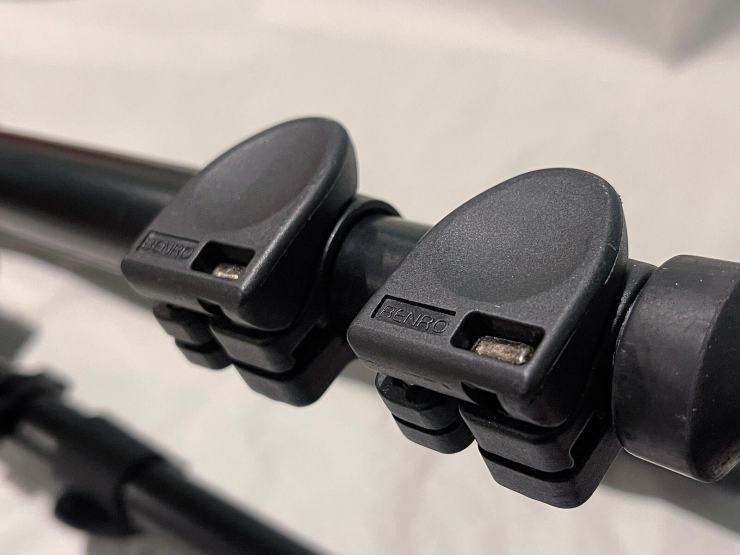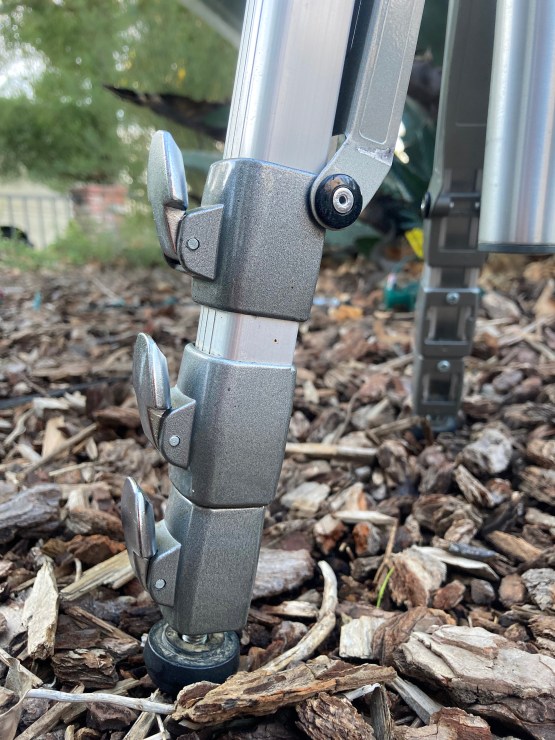You’ve noticed that tripods come with two basic kinds of locks — twist locks and lever locks. They’re quite different. Which should you purchase? I’ll tell you my experiences and observations.
Twist locks

I generally like twist locks, or collar locks, but I feel that you have to really go out of your way to make sure that they are locked down because occasionally, if you are not careful, they can slip.
Using twist locks
A great advantage is that you can grab all the twist locks and untighten them simultaneously and deploy everything quickly. You can also, after collapsing the legs, tighten them all down in one motion as well. This is especially true of well-made tripods.
This maneuver is relatively quick. However, in practice, I believe lever locks still are faster when setting up the tripod. I’ll mention why later.
Maintenance of twist locks
If you photograph in really sandy, dirty places like I do (desert, beach), they can eventually get sand caught in there, and you have to take it apart, clean and lubricate it with marine grease. This is in practice not really a bad thing as I’ve only had to take my tripods apart once or twice in the last eight or nine years, and it’s rather simple to do.
Lever locks

The advantage of lever locks, or clamp locks, is that you KNOW when they are locked down. I mean, you’re 100% sure. You can visually see it. And when you are pressing the clamp down, you can feel it.
Using lever locks
With lever locks, you can accidentally pinch your finger. I’ve never had this happen with twist locks. The locks also sometimes snag on cactus and branches.
Some people say that it hurts their hands when they lock it down. Some with arthritis have mentioned that it’s too hard on their hands. I’ve never had this issue, thankfully, but I thought I might pass this along.
The people who love lever locks really love them and will avoid twist locks at all costs. I get it. There’s a simplicity in locking your legs down, knowing that they’re locked.
Maintenance of lever locks
From my limited experience with lever locks, they seem to loosen up over time. I’ve also seen more people with broken lever locks than twist locks. This is despite the fact that most of the night photographers I know use twist locks. This makes me believe that if you are going to get a tripod with a lever lock, don’t get cheap ones.
My opinion so far
In theory, I prefer lever locks.
In practice, however, lever locks catch on things either in my car, in storage, or even in the field. My twist locks don’t pull my underwear out of my backpack. They don’t snag on creosote or tree branches. They don’t hitch on to my baggy pants or shorts. I unfortunately speak from experience.
Consequently, I use twist locks.
If you are less clumsy than me or if you are not in these environments, I would give lever locks some serious consideration.
Bonus tip: My twist lock routine
While using twist locks, though, I have gotten in the habit of checking everything before trusting that my tripod is rock solid and ready to go. This is my routine:
- I twist the locks twice
- I push my tripod into the ground once or twice to make sure that it sinks down and doesn’t have any issues. Because I mostly photograph in the desert or on the coast, I was already in the habit of pushing my tripod down to create additional stability.
Because of this, I believe that using a tripod with lever locks is quicker and more convenient. It might be quicker anyway. And again, there’s that knowledge of knowing that a lever lock is, well, locked.
If you are going to use a tripod with twist locks, try this routine. It works really well for me and has become a habit.

Tell your story with the second annual Visual Storytelling Conference!
Experience four days of interactive, online training sessions featuring a range of educational content with experienced photographers and content creators. This free event kicks off with a series of technical boot camps to build essential skills, followed by live, online sessions on photography, video, business and social media. Join live from March 10-13, 2022!
